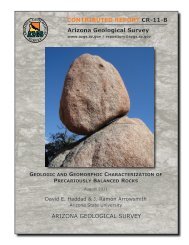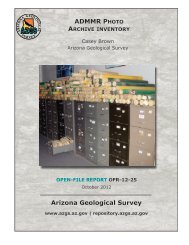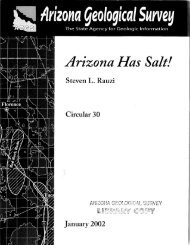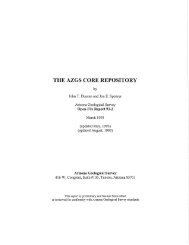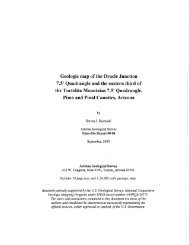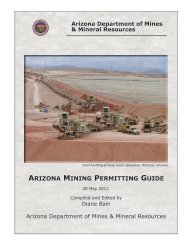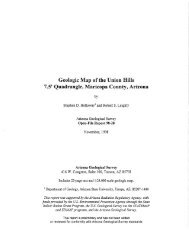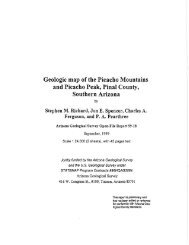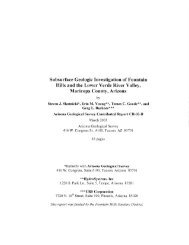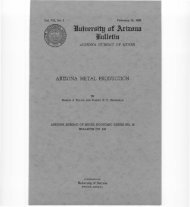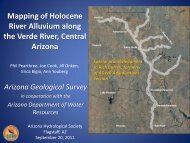Geology of the Virgin and Beaverdam Mountains, Arizona - AZGS ...
Geology of the Virgin and Beaverdam Mountains, Arizona - AZGS ...
Geology of the Virgin and Beaverdam Mountains, Arizona - AZGS ...
Create successful ePaper yourself
Turn your PDF publications into a flip-book with our unique Google optimized e-Paper software.
ABSTRACT<br />
The <strong>Virgin</strong> <strong>and</strong> <strong>Beaverdam</strong> <strong>Mountains</strong> form an arcuate range in<br />
northwestern Mohave County, <strong>Arizona</strong>, which extends nor<strong>the</strong>asterly from<br />
<strong>the</strong> Nevada State line <strong>and</strong> swings to a nor<strong>the</strong>rly trend near <strong>the</strong> Utah<br />
boundary. The range lies on <strong>the</strong> eastern edge <strong>of</strong> <strong>the</strong> Basin-<strong>and</strong>-Range<br />
province, adjacent to <strong>the</strong> Plateau province, <strong>and</strong> has a maximum<br />
topographic relief <strong>of</strong> nearly 6,500 feet.<br />
Rocks ranging in age from Precambrian to Tertiary are exposed in<br />
<strong>the</strong> <strong>Virgin</strong> <strong>and</strong> <strong>Beaverdam</strong> <strong>Mountains</strong>. Precambrian rocks consist <strong>of</strong> a<br />
metamorphic <strong>and</strong> igneous complex. The Paleozoic Era is represented by<br />
marine carbonate rocks with subordinate, fine-grained clastic material.<br />
Mesozoic <strong>and</strong> Cenozoic rocks are for <strong>the</strong> most part clastic units <strong>of</strong><br />
continental origin.<br />
Structural elements that have played a major part in <strong>the</strong> development<br />
<strong>of</strong> <strong>the</strong> range include a large anticlinal fold <strong>and</strong> a zone <strong>of</strong> reverse faulting<br />
that extends for nearly 20 miles along <strong>the</strong> eastern flank <strong>of</strong> <strong>the</strong> range. The<br />
basic pattern established by <strong>the</strong>se structures has been modified by highangle<br />
faults <strong>of</strong> large displacement which strike substantially parallel with<br />
<strong>the</strong> line <strong>of</strong> reverse faulting, <strong>and</strong> by transverse faults <strong>of</strong> less displacement.<br />
In <strong>the</strong> nor<strong>the</strong>rn part <strong>of</strong> <strong>the</strong> range low-angle thrust faulting is locally<br />
prominent.<br />
The structural elements can be divided temporally into three episodes<br />
<strong>of</strong> deformation: (I) post Jurassic to mid-Cretaceous(?) folding <strong>and</strong> thrustfaulting<br />
along north-trending axes, (2) late Cretaceous to pre-Middle<br />
Miocene folding <strong>and</strong> steep reverse faulting along nor<strong>the</strong>ast trending axes,<br />
<strong>and</strong> (3) Late Pliocene(?) to Recent normal faulting striking nor<strong>the</strong>asterly.



